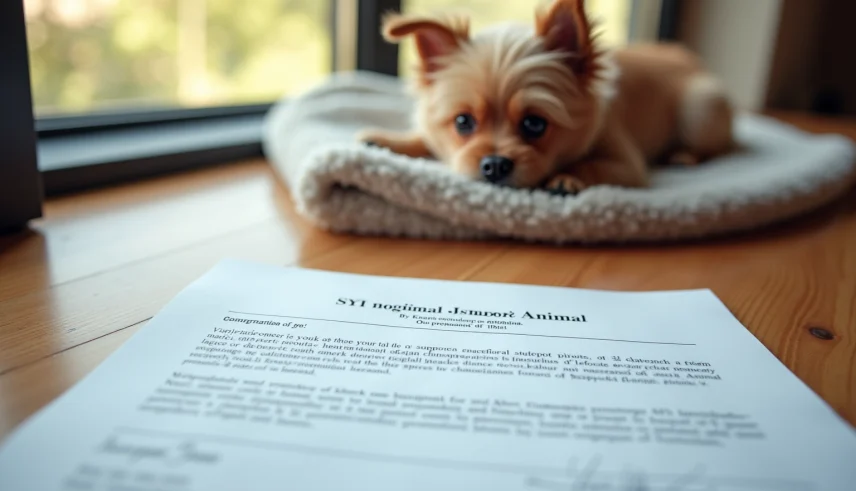
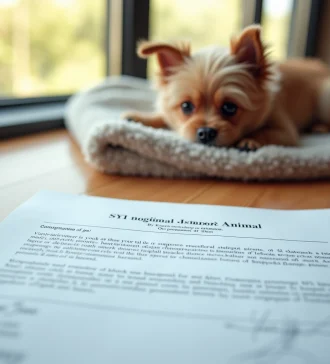
What Does a ESA Letter Look Like? Key Features Explained
by Lena Park
Last updated: August 6, 2025
Verified and Approved by:
Angela Morris,
MSW, LCSW
Fact Checked

Overview
The article highlights a significant aspect of support for individuals grappling with mental health challenges: the Emotional Support Animal (ESA) letter. This formal document, issued by a licensed mental health professional, includes essential details such as the patient’s name, the professional’s credentials, and a heartfelt statement confirming the need for an emotional support animal.
For many, this letter serves as a beacon of hope, providing crucial legal protections under the Fair Housing Act and the Air Carrier Access Act. It allows individuals to live with and travel alongside their beloved ESAs, enhancing their emotional well-being and fostering a sense of companionship during difficult times.
This compassionate support can make a profound difference in the lives of those who need it most.
Introduction
Understanding the nuances of Emotional Support Animal (ESA) letters is vital for individuals navigating the emotional landscape during challenging times. These letters not only affirm the necessity of an emotional support animal but also offer essential legal protections that can greatly improve the quality of life for those grappling with mental health issues.
Many may find themselves asking: what does an ESA letter entail, and how can one ensure it fulfills the required criteria? By exploring the key components and unique characteristics of ESA letters, we uncover their importance and the potential obstacles individuals may face in securing their rights and support.
It’s a journey worth taking, as the comfort and companionship of an ESA can be transformative.
Defining the Emotional Support Animal (ESA) Letter
An Emotional Support Companion (ESA) confirmation is an official document provided by a licensed mental health expert that verifies a person’s need for an emotional assistance animal, prompting many to ask, what does a esa letter look like? This document serves as vital evidence that the individual has a mental health condition that benefits from the companionship of a pet. Unlike service animals, which are trained to perform specific tasks, ESAs offer comfort and emotional support simply by being present. To understand what does a esa letter look like, the document must be composed on official letterhead and include the professional’s credentials, ensuring its legitimacy and adherence to legal standards.
ESA documents are typically valid for one year from the date of issuance, highlighting the importance of timely updates to this documentation. In the United States, thousands of ESA documents are issued each year, with Wellness Wag effectively assisting over 50,000 patients, delivering prompt ESA documents within 24 hours of approval.
The significance of these documents cannot be overstated, as they enable access to housing and travel arrangements for individuals facing mental health challenges. Licensed experts emphasize that ‘an official ESA document must clarify what does a esa letter look like in terms of how the animal assists the individual with their mental health issue,’ underscoring the importance of a genuine therapeutic connection.
Real-world examples illustrate the impact of ESA documents: individuals living in pet-restricted accommodations can present their ESA documents to landlords, ensuring their rights under the Fair Housing Act are upheld. This legal protection allows them to reside with their emotional companions without incurring extra fees or limitations, as landlords cannot impose additional pet charges for emotional assistance animals with valid ESA documentation. This assurance significantly contributes to their overall well-being.
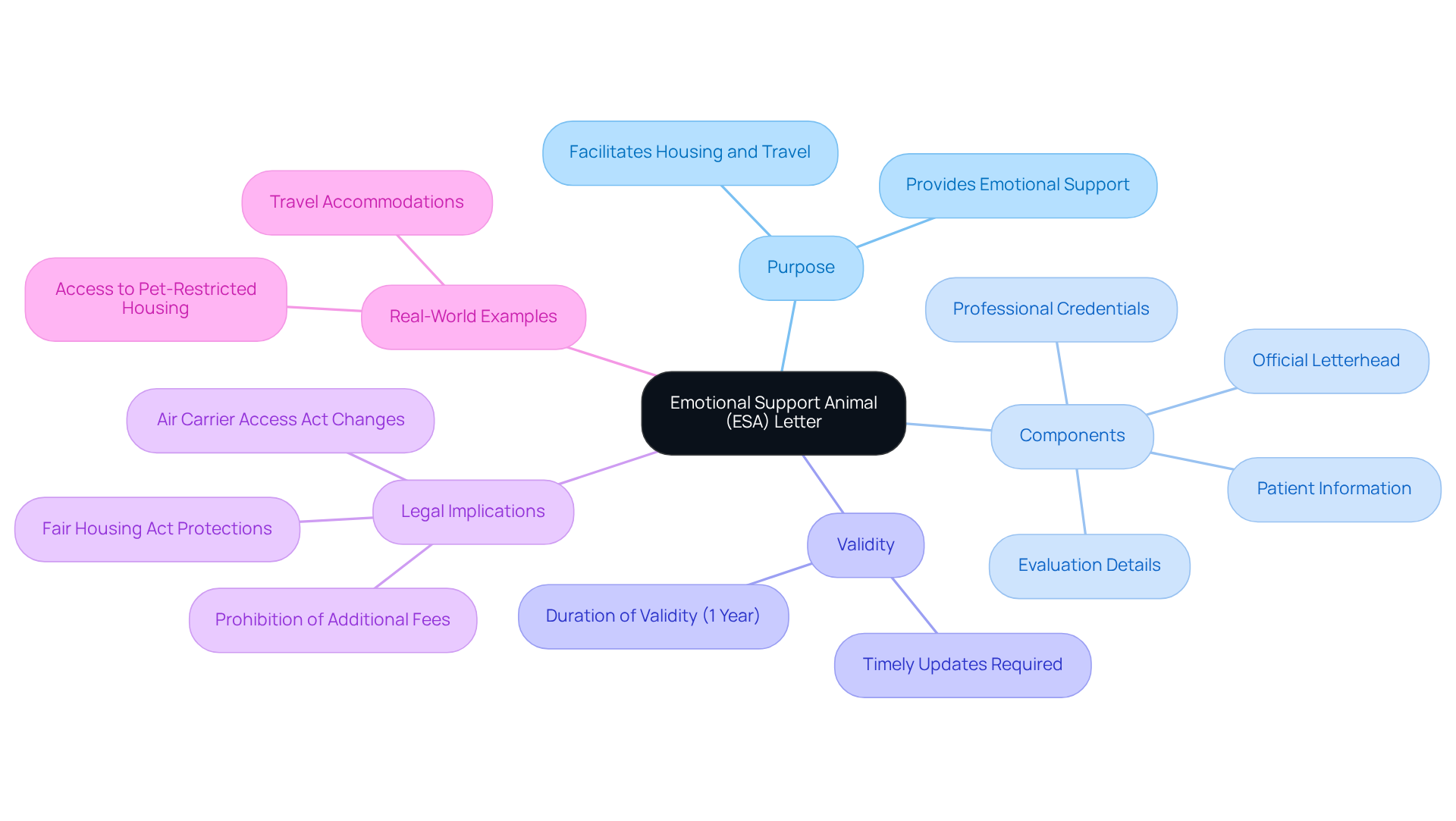
The Importance of ESA Letters for Mental Health Support
For individuals grappling with mental health conditions such as anxiety, depression, and PTSD, ESA letters serve as a vital lifeline. These letters provide essential legal protections under the Fair Housing Act and the Air Carrier Access Act, allowing individuals to keep their emotional support animals in pet-restricted housing and travel with them on airlines. The presence of an ESA can significantly alleviate symptoms of mental distress, offering companionship and emotional stability during challenging times.
Consider the emotional toll that anxiety, depression, or PTSD can take on daily life. A small study from 2021 found that interactions with emotional support animals led to a statistically significant decrease in feelings of depression, anxiety, and loneliness. Participants reported increased oxytocin levels and decreased cortisol levels after just ten minutes with their ESAs. This is especially crucial for those who may feel isolated or overwhelmed by their conditions, highlighting the importance of understanding what does a esa letter look like as a key resource for accessing these benefits.
For working professionals navigating high-pressure environments, having an ESA can be an invaluable tool for managing stress and fostering emotional well-being. It’s reassuring to know that support is available through these documents, which can make a meaningful difference in one’s quality of life. Furthermore, Wellness Wag offers flexible payment options starting at $32.25, making it easier for individuals to seek this essential assistance. In moments of struggle, remember that you are not alone; the support of an ESA can truly transform your journey toward emotional stability.
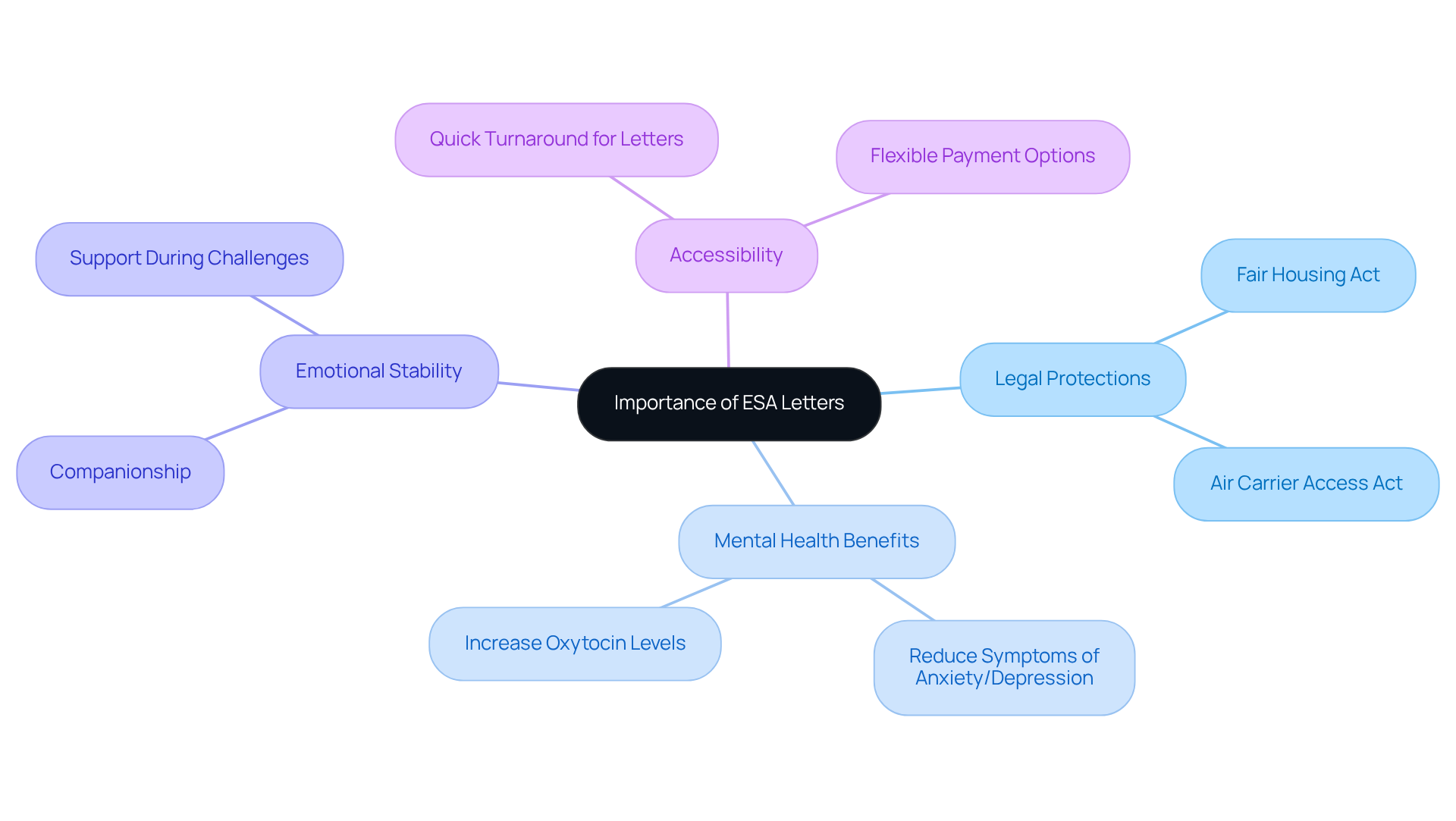
Key Components of an ESA Letter: What to Expect
A legitimate Emotional Support Animal (ESA) document is essential for individuals seeking comfort and companionship during challenging times. This document must contain several critical components to ensure its validity and compliance with legal standards. Key elements include:
- The patient’s full name
- Details about the mental health professional—such as their license number and contact information
- A statement confirming the patient’s mental health condition
- A clear recommendation for an emotional support animal
This leads to the question of what does an ESA letter look like. It is important that this document, which illustrates what does an ESA letter look like, is dated and signed by the licensed professional, providing a sense of security and support.
According to a survey conducted by the National Service Animal Registry in 2023, ESA documents issued by licensed professionals are generally valid for one year. This underscores the importance of obtaining a properly documented statement, especially for understanding what does an ESA letter look like, a step that can bring peace of mind. Furthermore, including specific details, such as the mental health condition and how the ESA alleviates symptoms, is crucial for compliance with laws like the Fair Housing Act and the Air Carrier Access Act. As noted by Wellness Wag, “A legitimate ESA document must be composed by a licensed mental health professional and should include the client’s diagnosis, the type of suggested pet, and the provider’s credentials.” This ensures that individuals can effectively advocate for their rights in housing and travel situations.
It is also important to acknowledge that ESA owners may encounter difficulties, such as landlords doubting the validity of ESA documentation. This reality can be disheartening, making it vital to possess a well-documented statement. Remember, you are not alone in this journey, and having the right documentation can empower you to navigate these challenges with confidence.
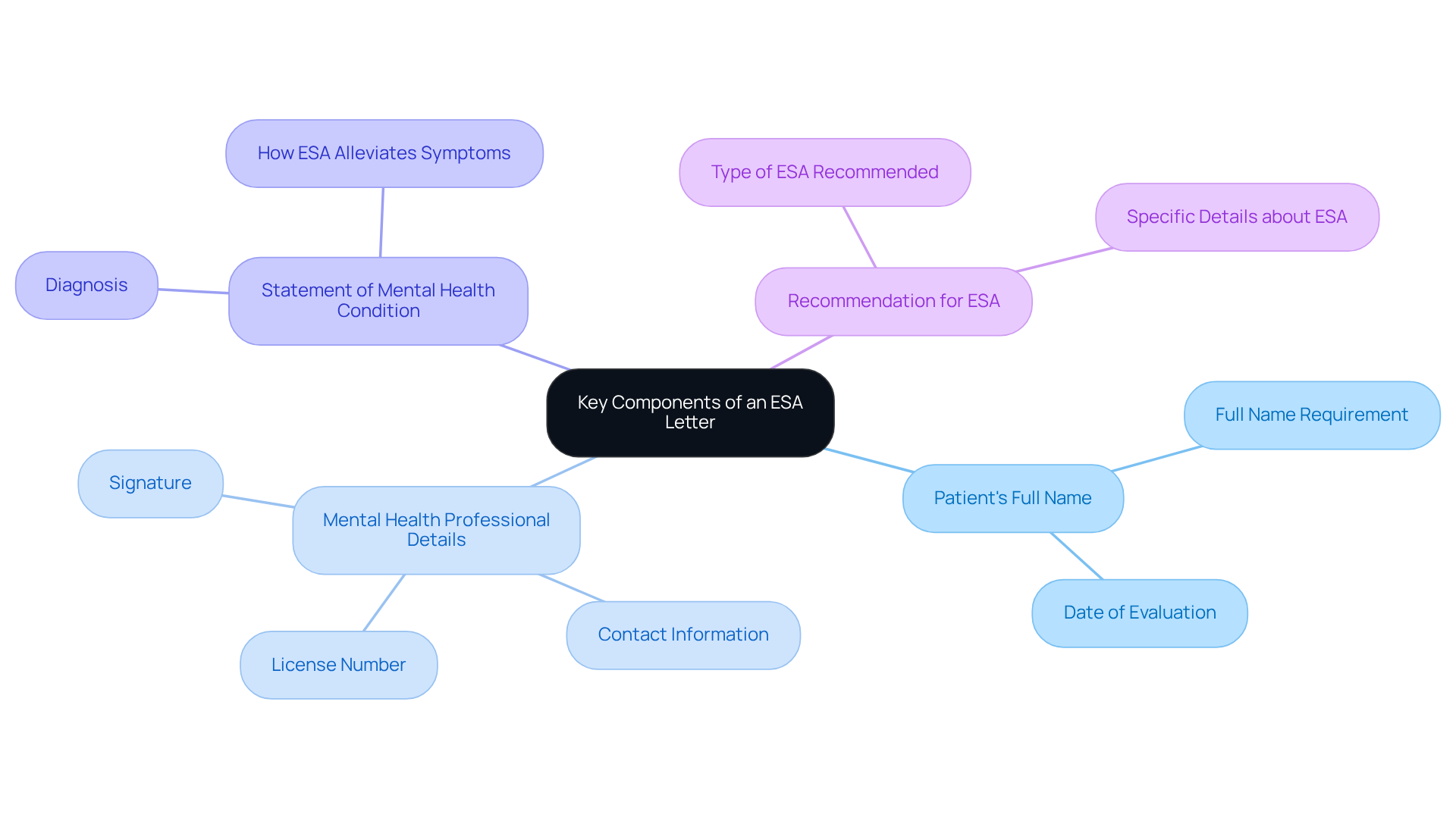
Distinguishing ESA Letters from Other Animal Support Documents
Understanding what does a esa letter look like, along with the differences between ESA letters, service creatures, and therapy creatures, is essential for those navigating the complexities of animal support documentation. Many individuals face emotional challenges, and it is important to recognize how these distinctions can impact their lives.
- Assistance creatures, specifically trained to perform tasks for individuals with disabilities, are protected under the Americans with Disabilities Act (ADA), allowing them access to public spaces.
- In contrast, Emotional Support Animals (ESAs) do not require specialized training; their primary role is to provide emotional support.
- Therapy creatures are utilized in therapeutic settings to aid various individuals, yet they lack the same legal protections as ESAs.
Statistics reveal that public knowledge of ESA documents is significantly lower than that of service creature certifications. For instance, a systematic review identified only 21 relevant studies on companion creatures and human loneliness, highlighting a gap in understanding the legal rights and benefits associated with ESAs. Legal specialists emphasize that while ESA letters serve as valid proof for emotional assistance, what does a esa letter look like does not equate to the rigorous training and public access privileges of service creatures. As noted by Paige Cerulli, “ESAs have fewer rights than service dogs.”
It’s crucial to recognize that the Fair Housing Act (FHA) and the Air Carrier Access Act (ACAA) offer essential legal protections for ESAs.
By understanding these differences, individuals can better navigate their emotional journeys and access the support they need. The challenges can feel overwhelming, but knowing the distinctions and the protections available can provide reassurance. Remember, you are not alone in this journey, and there are compassionate solutions available to help you find the support you deserve.
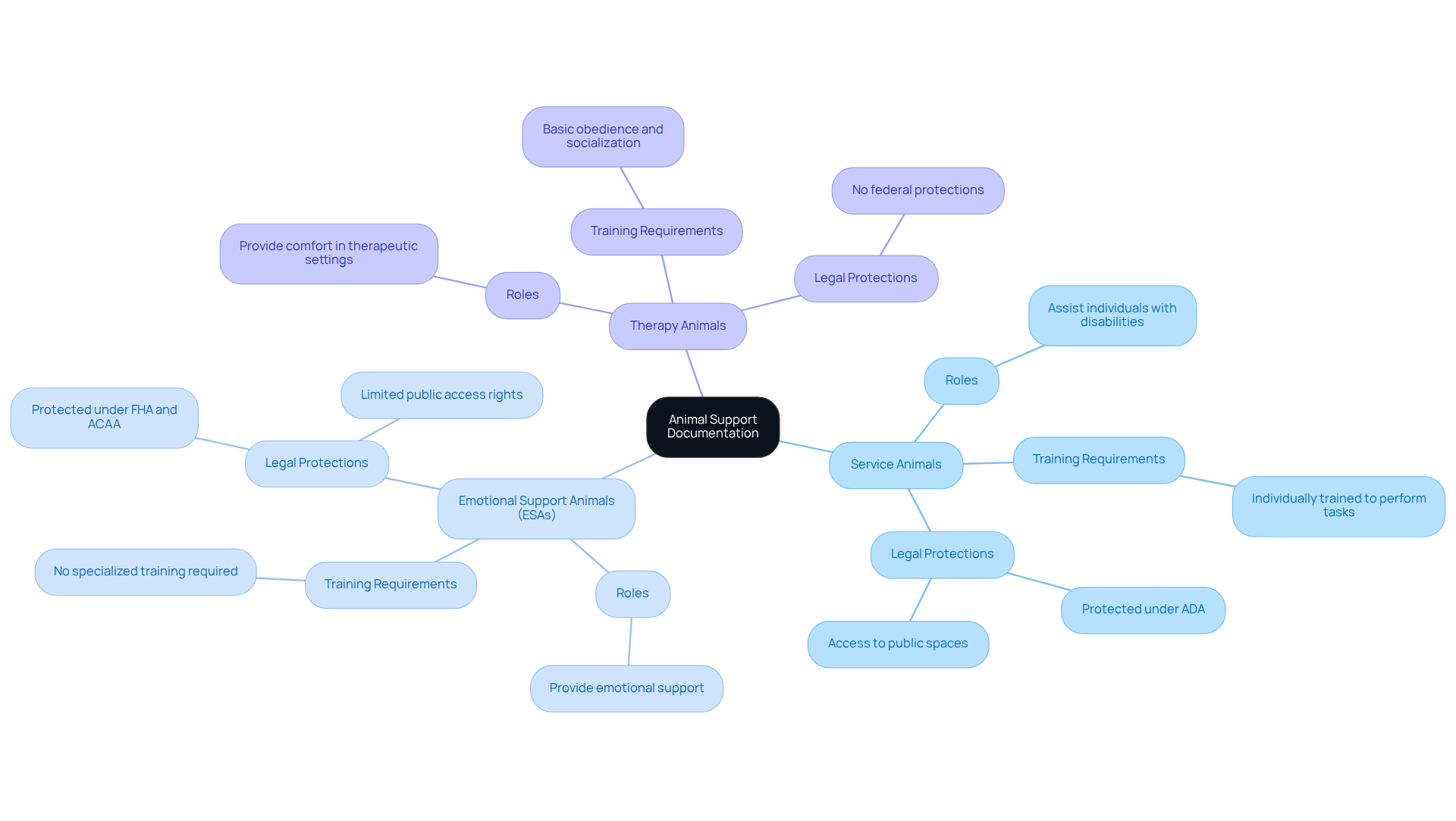
Conclusion
An Emotional Support Animal (ESA) letter is essential for individuals seeking comfort and companionship during difficult times. This letter serves as a formal acknowledgment from a licensed mental health professional, affirming that an individual requires an emotional support animal to help manage their mental health conditions. Understanding the structure and significance of this document is vital for those who wish to benefit from the emotional stability and legal protections that accompany having an ESA.
Many individuals face emotional challenges that can feel overwhelming. An ESA letter not only provides a clear recommendation for an emotional support animal but also includes important details such as the patient’s name and the mental health professional’s credentials. These letters are crucial in granting legal rights under the Fair Housing Act and the Air Carrier Access Act, allowing individuals to live and travel with their emotional support animals without facing discrimination or incurring additional fees. Real-world examples illustrate how these letters empower individuals to advocate for their rights, ensuring they can access the companionship that significantly enhances their well-being.
Ultimately, the importance of ESA letters goes beyond mere documentation; they represent a vital resource for individuals navigating mental health challenges. By understanding what an ESA letter looks like and the protections it offers, individuals can take proactive steps toward improving their emotional health. It is essential to seek the necessary documentation to unlock the benefits of having an emotional support animal, fostering a supportive environment that nurtures mental well-being. Remember, you are not alone in this journey, and the support you need is within reach.
Frequently Asked Questions
What is an Emotional Support Animal (ESA) letter?
An ESA letter is an official document provided by a licensed mental health professional that verifies a person’s need for an emotional support animal due to a mental health condition.
How does an ESA differ from a service animal?
Unlike service animals, which are trained to perform specific tasks, emotional support animals provide comfort and emotional support simply by being present.
What should an ESA letter include?
An ESA letter must be composed on official letterhead and include the mental health professional’s credentials to ensure its legitimacy and adherence to legal standards.
How long is an ESA letter valid?
ESA letters are typically valid for one year from the date of issuance, making timely updates important.
Why are ESA letters significant?
ESA letters enable individuals with mental health challenges to access housing and travel arrangements, ensuring their rights are upheld under laws like the Fair Housing Act.
Can ESA letters help individuals in pet-restricted accommodations?
Yes, individuals can present their ESA letters to landlords, allowing them to reside with their emotional support animals without incurring extra fees or limitations.
What is the role of Wellness Wag in providing ESA letters?
Wellness Wag assists over 50,000 patients by delivering prompt ESA documents within 24 hours of approval.
Certify Your Emotional Support Animal Today

Why You Can Rely on Us?
At Wellness Wag, we believe your pet deserves care rooted in both science and compassion. Each article is carefully researched, written in clear language for pet owners, and then reviewed by qualified professionals to ensure the information is evidence-based, current, and practical for real-life care. Our goal is to help you feel confident in making informed decisions about your pet’s health and well-being.
Reviewed by
Angela Morris, MSW, LCSW
Angela is a licensed clinical social worker with 20 years of experience in patient advocacy and community mental health. She has assisted numerous clients with ESA evaluations and brings a deep understanding of disability accommodations, ensuring that all information is accurate, supportive, and practical.

Written by :
Lena Park
Last Updated :
August 6, 2025












